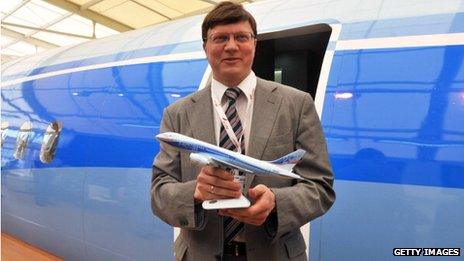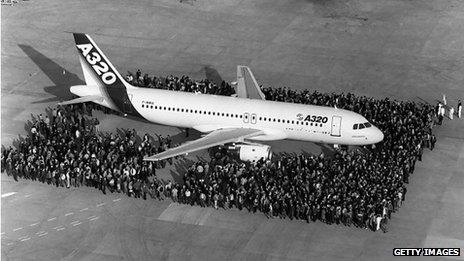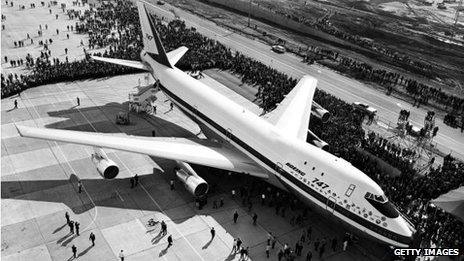Paris Air Show: Rival planemakers have Boeing and Airbus in their sights
- Published

As usual, the Paris Air Show has been dominated by the two big beasts of the industry.
Will Airbus announce more orders than Boeing? Will Boeing have more products on display than Airbus? Whose vision of the future of air travel looks most credible?
But below the radar are signs that this duopoly may one day be challenged. China and Russia have a huge presence in Paris.
Canada's Bombardier is within days of the first test flight of its much-anticipated C-Series aircraft, arguably the most serious potential rival in the 100-200 seat narrow-body, or single-aisle, market dominated by Airbus's A320 and Boeing's 737.
That market is forecast to be worth $20 trillion (£12.8tn) over the next 20 years. There are a lot of contracts for new entrants to aim for.
Meanwhile, further down the aircraft food chain are regional planemakers Embraer and Mitsubishi. Both are thought to have plans for larger planes on their drawing boards.
Canada's Bombardier is within days of the first test flight of its much-anticipated C-Series aircraft
Guy Hachey, president of Bombardier's aerospace operation, is keen not to overplay his hand when talking about competing with Boeing and Airbus.
"We are scratching around at the bottom. We are, maybe, an irritant," he says.
But the C-Series' acknowledged improvement in fuel efficiency - a result of a new-generation engine and use of advanced composites - has already prompted Airbus and Boeing to make new variants of existing aircraft.
China's ambitions

Comac hopes its C919 will be the plane of choice for Chinese airlines
At the Paris show, Bombardier and Commercial Aircraft Corporation of China (Comac) announced plans to expand a cooperation deal.
It will involve sharing "commonalities" between the C-Series and Comac's proposed C919 aircraft. There will be no cooperation on flight testing, but rather in areas such as suppliers, customer service, and some technical issues.
It means, says Hachey, that Bombardier gets to strengthen its partnership in what will be the single biggest market for aircraft over the next couple of decades. And Comac gets to draw on Western expertise to help push along its civil aircraft ambitions.
Boeing estimates that China will have about 2,200 civil aircraft by 2020, with the market dominated by single-aisle aircraft.
Comac sees its C919 as grabbing a large slice of orders from domestic airlines. And given the size of the Chinese market, these orders should be enough to underpin the industry until other international airlines are convinced of the planes' operability.
The C919 is due to be rolled out in 2014, with deliveries in 2016. But the aircraft has already been delayed and few people would be surprised if that timetable slipped further.
Almost 50 Russian companies are at the show, most operating under the wing of United Aircraft Corporation, the state-run enterprise formed in 2006 to boost the domestic aircraft industry. The Kremlin is putting about $40bn into the civil sector over the next two decades.
Aeroflot order

Kirill Budaev says Russian planemaker Irkut can rival Boeing and Airbus
The Irkut MC-21, developed at a cost of $5bn, is the great hope of Russian civil aviation. The huge mock-up at the air show looked and felt every inch the new-generation airliner it wants to be. But a static display at an air show is a lot different to an aircraft that can fly.
Despite much speculation about the MC-21's development timetable, Kirill Budaev, vice president at Irkut, insisted that there will be a maiden flight in 2015, certification in 2017, and then a delivery programme starting in 2020.
And he is very clear where he wants Irkut to be in a couple of decades - building a family of aircraft that will knock either Boeing or Airbus off their perch, or join them as a third force in global aviation.
"We can match Boeing and Airbus. Look at the growth in aviation. There is plenty of business to be done. We will be there: third, second, first in the market," he says.
Russia is putting in place a tax regime that will help its domestic aircraft industry, Mr Budaev said.
Tax breaks that allow domestic airlines to buy foreign aircraft more cheaply are being phased out, to be replaced by leasing deals - underwritten by Moscow - that will benefit overseas airlines buying Russian-made planes.
"We will provide customer support," Mr Budaev says. "We will do what we can to help."
Times change
These are bold claims, and bold ambitions. But history shows that manufacturers can displace the incumbent market leaders. It just takes a long time.
The UK aircraft industry was eventually eclipsed, while Airbus was, after all, once an under-rated upstart.

Airbus' A320 made its first flight in 1987

Boeing rolled out the first 747 in 1968
Rob Morris, senior analyst at the aviation consultancy Ascend, says: "Airbus was forced to innovate with the A320 and continued to innovate to achieve the position it shares with Boeing today. Embraer 'innovated' their way into the regional market and forced the incumbent manufacturers to exit."
He does not underestimate the development and entry-into-service challenges faced by Irkut or Comac, but he is in little doubt that they will deliver into domestic and adjacent markets.
And in doing so, the Chinese and Russian manufacturers "will also have gained experience of design, manufacture and delivery of large commercial which they will leverage into their next programmes, either wide-body or single-aisle," Mr Morris says.
Nigel Cassidy spoke to EADS boss Tom Enders at the Paris Air Show
But the sceptics are many. Richard Aboulafia, analyst at Teal Group, says: "At every air show there seems to be more smoke - but still very little heat and light. In commercial terms there is very little activity."
He believes that the Bombardier C-Series has the best chance of breaking through, but he then cites a startling statistic.
Airbus and Boeing have about 3,000 orders for their next-generation aircraft. Orders for Bombardier's C-Series are 177. "That's not enough to make it a success," he says.
As for the Russians and Chinese, it's the fact that the state is backing the projects that means they will struggle. "Government agencies trying to get into a commercial field - frankly, it's embarrassing," he says.
He believes that any new entrants will have to sell their aircraft at a serious loss for a decade to compete. "You will always be playing catch-up," he says.
But aircraft companies - and governments - are used to playing the long game. That's the nature of the industry. And Moscow and Beijing certainly have pretty deep pockets.
Boeing chief executive Jim McNerney knows a challenge is coming. The "cozy world" of just two huge planemakers may be almost over, he said.
And that comment was made in July 2010.